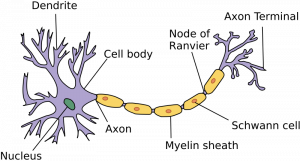Nervous system: Living Internet of the Body – DRAFT ONLY
Learning Objectives
Sensing anything or doing anything requires neurons to send messages to each other. The network re-wires itself as you learn.
Hi everyone! Today I am going to be telling you about the nervous system. I will cover basic components of the nervous system and how these parts work together to communicate. We will discuss how these elements relate to the internet and our computers that we all know and love and how the brain can change!
Central Nervous System
First let’s begin with the central nervous system, this is also called the CNS. The central nervous system is made up of the brain and spinal cord. When we think about the internet as a whole, that is how the central nervous system works. It is the body’s control center and it coordinates actions. The CNS receives messages from the world around you and then decides how to react to the information.
Peripheral Nervous System
The peripheral nervous system, also known as the PNS, carries information to and away from the central nervous system. Our devices that connect to the internet are like the PNS. There are two components of the peripheral nervous system, the autonomic nervous system and the somatic nervous system.
Autonomic Nervous System
The autonomic nervous system relays information from the central nervous system to the organs. The autonomic nervous system is automatic, also known as involuntary. For example, you don’t think about making your heart beat, the autonomic nervous system does it for you. There are two parts of the autonomic nervous system: the sympathetic and parasympathetic nervous systems. The sympathetic nervous system controls fight or flight responses. This is what kicks in if you were to see a hungry bear in the woods, you choose to either fight, or flee. This nervous system makes your heart rate increase and your digestion slow down, it calls you into action. The parasympathetic nervous system controls your body in times of rest. This is when you rest and your pulse slows and digestion can start.
Somatic Nervous System
Somatic means body. The somatic nervous system relays information between skin, skeletal muscles, and the central nervous system. You consciously control this pathway by deciding to move your muscles.
Neurons
All right, something has to be doing all of this messaging right? Right. That is done by neurons. Neurons are the basic unit of structure and function in the nervous system. Neurons are composed of a cell body, dendrites and axons. The myelin sheath wraps around the axon to propel the message from the cell body down the axon super fast.

Dendrites are branch-like extensions that receive impulses and carry them towards the cell body. Axons are a single extension of the neuron that carries action potentials or impulses, away from the cell body.
At the end of each neuron there is a synaptic terminal. Through this synaptic terminal neurons are able to communicate with each other through chemical neurotransmitters. The meeting of these terminals is called a synapse. At this synapse, an action potential causes a neuron to release a chemical neurotransmitter.
I like to think of the networks in our brain like a road. The ones we travel frequently are like the freeway, fast and accessible. The ones we don’t like a side street, are a little less easy to access. The idea of neuroplasticity is that we can turn a sidestreet into a fast and frequently traveled road if we take it enough. In the brain, new thoughts and skills carve out a new “road”. Repetition and practice strengthen these pathways and make them more accessible to our daily use. And old pathways that we don’t use often diminish. With repeated practice and repetition we can work towards a desired change and “rewire” our brains.
Now that we know some basic components of the brain, let’s relate them to the internet and computer. In addition to neurotransmitters, the brain, much like a computer uses electrical signals to send messages. They both transmit information, the computer uses binary code and the brain uses action potentials. Both the brain and computer can grow their memory. A computer’s memory can grow by adding chips and your brain’s memory can grow by forming stronger synaptic connections. And they both need energy, the brain needs nutrients and oxygen and your computer needs electricity.
All right, that’s all I have! Thanks for reading and I hope you learned a little something about the brain!
The neurons located in the brain and spinal cord
The neurons throughout the body which relays information to and from the central nervous system.
The series of neurons which automatically communicate information between your organs an the brain
The series of neurons which relay information between your brain and skin.
The series of neurons responsible for arousal. As in the adrenaline which prepares us for a fight or flight situation.
The series of neurons which calm down the body and restore normal functions which are inhibited by the sympathetic nervous systems (ie digestion).
The specific type of cells which make up the nervous system.
(Nucleus of the neuron) The structure of the neurons which controls the entire neuron's functions.
The part of the cell responsible for receiving information for other neurons.
The cell structure responsible for sending information to the next neuron.
The supporting structure which insulates the neuron. This allows the information to move faster.
The place where chemical messengers are released from the axon to communicate with another neuron.
chemical messengers which allow brain cells to communicate with each other.
The place where the dendrites of one neuron meet the axon of another neuron. This is where the chemical communication through neurotransmitters occurs.
The connections between neurons can change over time. They can be strengthened or weakened based on usage.
An electrical signal which relays information within a single neuron.

